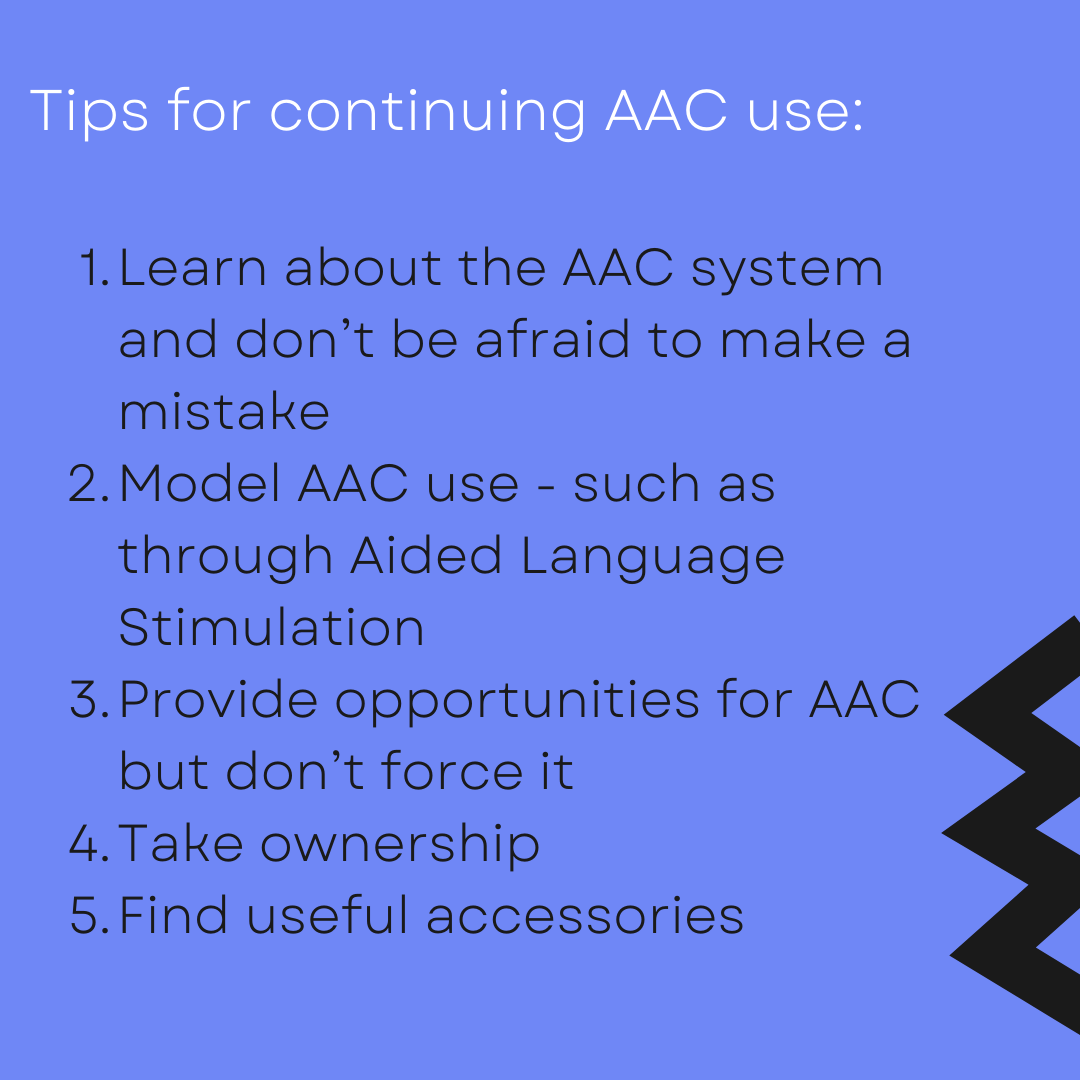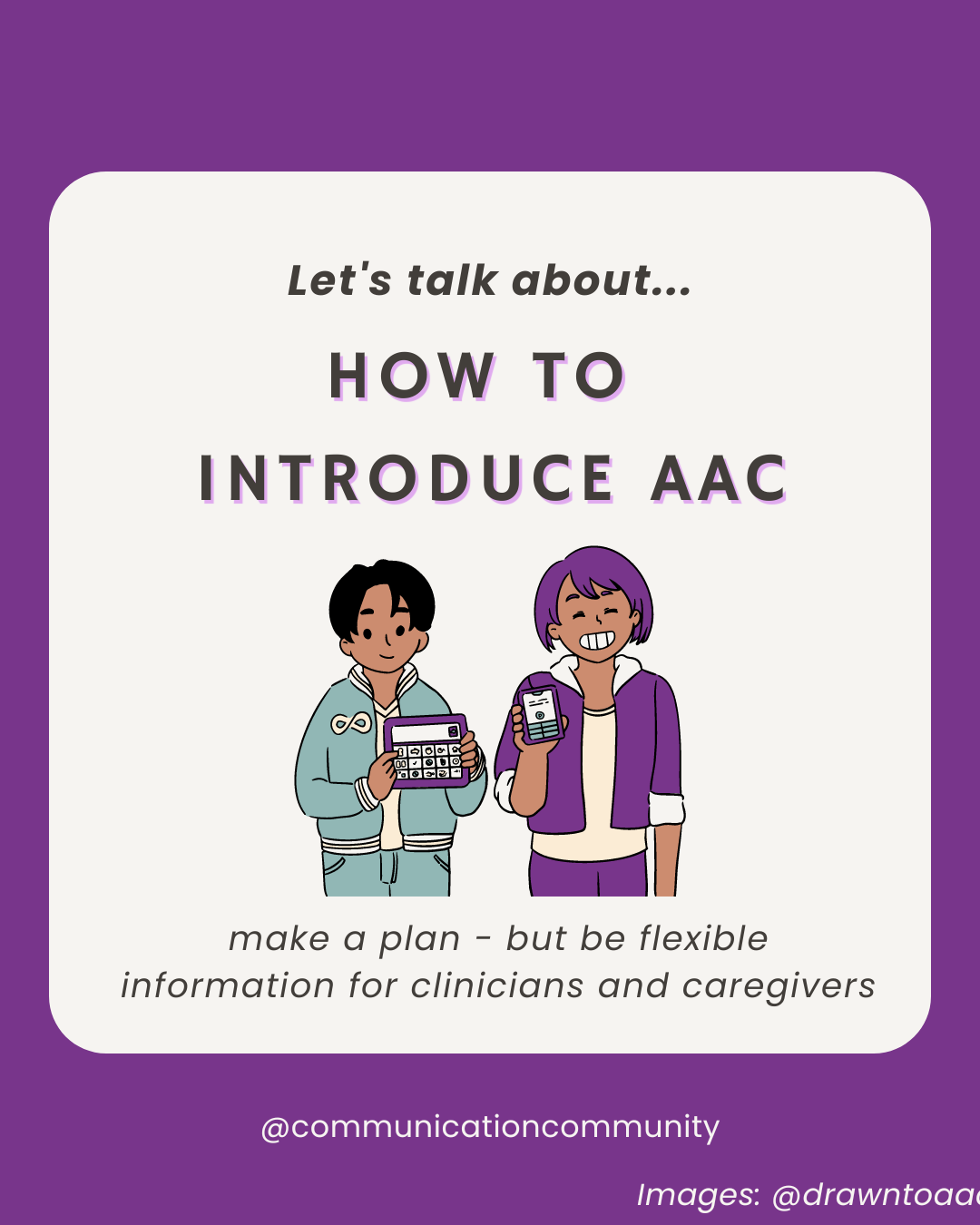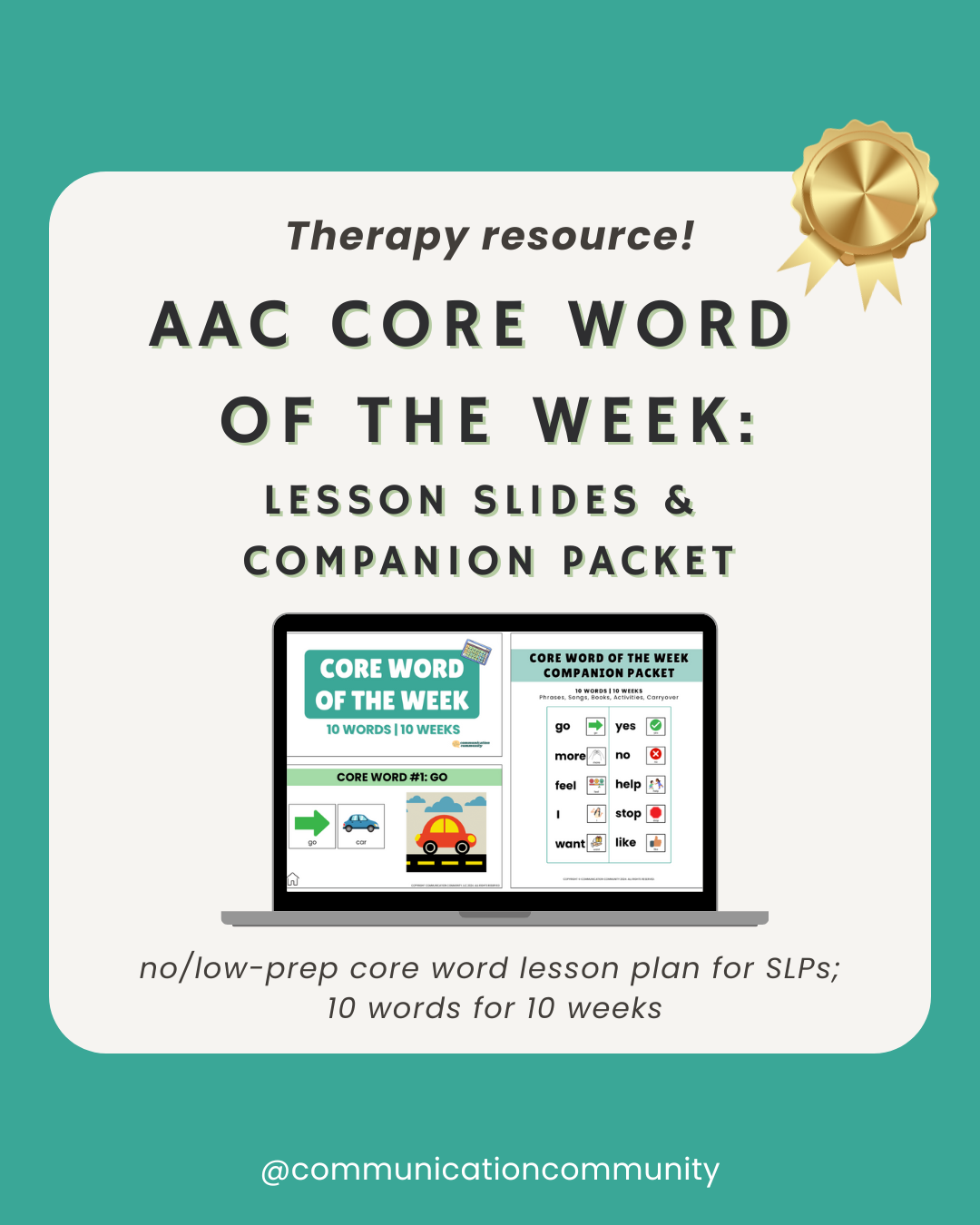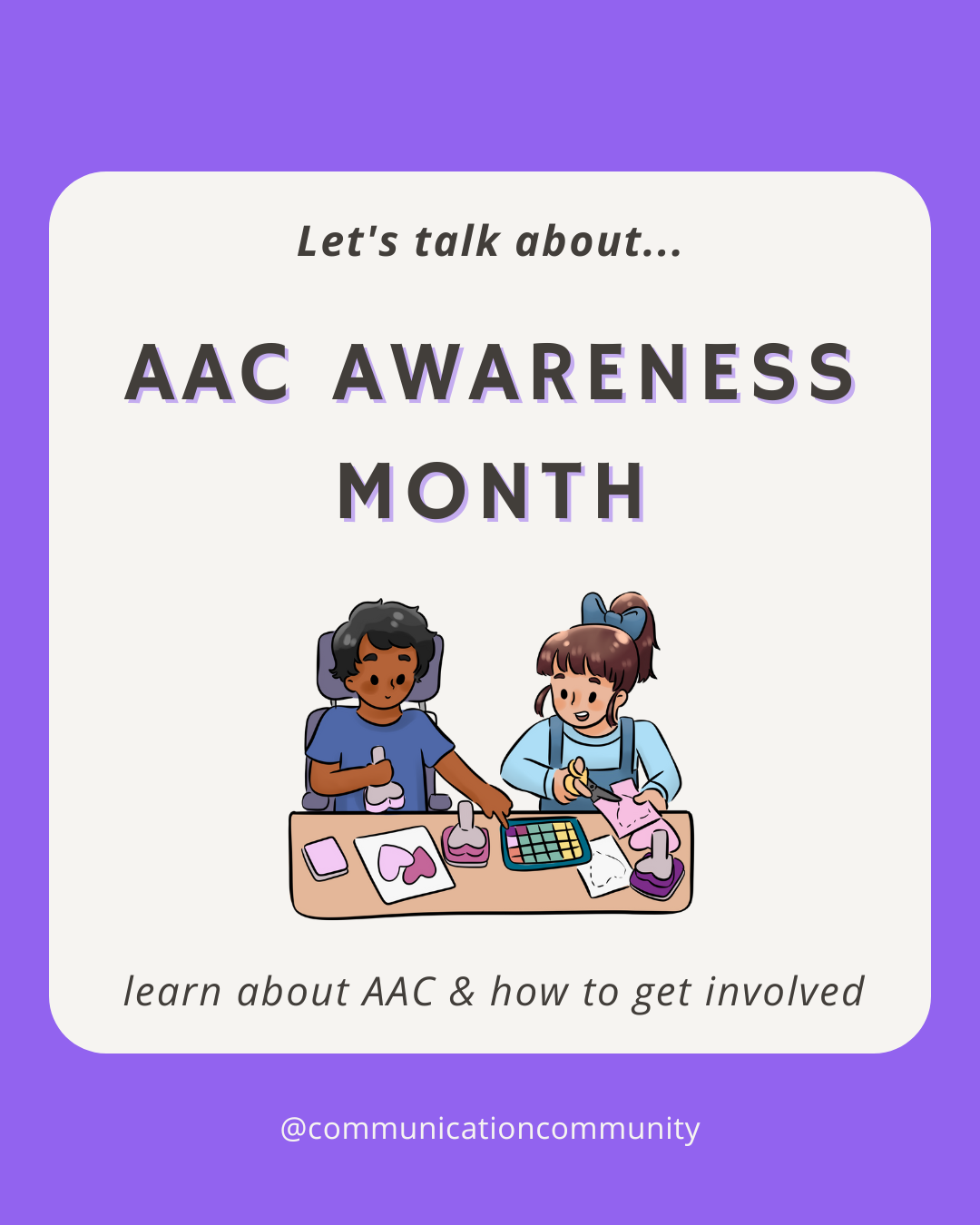Individuals who have complex communication needs (CCNs) may benefit from the use of augmentative and alternative communication (AAC). An individual with CCNs may not be able to speak, write, read or listen without support, which is why AAC has the potential to be very valuable to these communicators! Individuals of all ages use AAC every day to communicate.
Why Use AAC?
AAC allows individuals with CCNs to increase their ability to communicate their wants, needs, and ideas. Using AAC can increase an individual’s ability to get their message across to their communication partner(s) (aka - the individuals with whom they are interacting). In many cases, individuals who use AAC are considered total communicators or multi-modal communicators, which means that they can use a variety of modalities interchangeably (think: verbal language and an AAC system) when communicating with others.
Getting Started With AAC
If you are ready to explore AAC for an individual with CCN, where can you start?
Depending on the age of the individual with CCNs, there are a few different paths that you can take.
- Medical route: You can work with your primary care physician (PCP) to get a referral for speech therapy and/or AAC evaluation team. If this is your path, you will then work with an SLP who can introduce you to AAC. This is something you can ask your therapist. You may also work with related service providers, like occupational therapists (OTs) who may assist in positioning and ways to access AAC devices. This may include using mounts that rest on the floor or are attached to a wheelchair or different angles to set up an AAC device.
- Education route: If the individual with CCNs is enrolled in school, they may be introduced to AAC through school-based speech therapy services.
What do I do as an SLP?
If you are an SLP who will be introducing someone to AAC, it is important to be prepared. This means understanding the communication needs of the individual (or making a plan to gain this information).
Some of the things you can do to prepare for this include:
- Doing research. We have a number of articles about AAC and general speech and language evaluations, and we also encourage utilizing ASHA and other literature (peer-reviewed articles, books, continuing education units, etc.) to learn more about AAC. There is also a plethora of valuable information you can find on AAC software sites (linked below).
- Speak to a clinician with AAC experience or better yet, an AAC/AT (assistive technology) specialist! If there is someone you can consult with that has a lot of experience with AAC, they may be extraordinarily helpful. This may include a local AAC team in your area or consultants from various AAC companies (e.g. Tobii Dynavox, PRC-Saltillo, or Lingraphica - among many others).



What to Remember When Introducing AAC
Before introducing AAC to any individual, I remember three things:
- Assume competence. Assume that the individual you’re working with is able or is going to be able to use a system. There are no prerequisites for communication and using AAC systems. That being said, there will be times when AAC is not the best fit for an individual.
- Be flexible. Being able to make changes quickly and “going with the flow” are necessary for many areas of speech and language but are especially necessary when using AAC. Making changes and adjusting plans are very common when using AAC.
- It’s okay if it doesn’t “work” at first. You may have done all the preparation you could and thought you had plans/activities and backup plans/activities, and still, the system you introduced didn’t go as planned.. It happens. It’s important to remember that learning a system can vary considerably from individual to individual.
Making an AAC Introduction Plan
We know that planning is important for providing services, but introducing AAC is definitely a situation when planning is very important.
This involves collecting any background history on the individual, which may include medical history, prior speech therapy services history, what the individual’s current language use and understanding are, and where they’re at in terms of literacy.
There are various AAC assessment tools you can use to evaluate an individual’s communication skills in a variety of ways.
High tech AAC: If you are going to trial a high tech AAC device, it is beneficial to have an AAC device or application ready to go. There are a number of free apps that can be downloaded to an available tablet. Spend time finding an app that you think will be helpful AND learn how to program a few words and edit some pages on it. Be familiar with making adjustments with the volume, the size of the buttons, and what the buttons look like.
Mid or low tech AAC: If you are going to trial a mid or low tech AAC device, also have some of these options available and know how to customize/modify them quickly. This may be communication books or boards, a Big Mack button(s), and/or a GoTalk.
Access options: Having a variety of access options available may be key as well. This can look like having a stylus or stand where you can adjust the angle of an AAC device. This can also look like being ready to sit, stand and move the AAC device around if needed. To accommodate the clients I have worked with, I’ve introduced AAC in a variety of positions per their physical needs or wants: on the ground, under a table, on a couch, at a desk, etc. It’s important to consider these options and be prepared when thinking about how the individual will access their device.
AAC Introduction Activities
Having an app and a communication book ready to go is great, but you also need to figure out what kinds of activities you’re going to do while you get started. Depending on the individual you are working with, there are different ways to approach this. I like to incorporate preferred activities as it is an easier and more natural way to encourage communication. Having “buy in” is important for continued AAC success.
If you are going to begin by introducing core words, I like to have a few core words in mind that I may target and 3-5 activities that can relate to these words. Activities may include using preferred toys or items, music, videos, and food/drink. If I am in a setting where individuals have preferred items/activities, I try to utilize those. I have also found that stickers, bubbles, crayons/markers, and play dough are loved by many! There are times when none of your initial “plans” are successful in engaging individuals, which is why having a number of backup plans is key.
If you are going to introduce AAC with an individual who has strong language skills but needs support due to conditions such as aphasia, brain injury, or a neurodegenerative condition, I try to find topics that they’re interested in or are important to communicate and target these areas. This may include communicating feelings and needs, such as being in pain or needing assistance. Some individuals may be encouraged to communicate about things that they really enjoy, which can include family members they see or hobbies they partake in regularly.
Tips for Continuing AAC Use
Whether you have worked with an SLP to introduce an AAC system for you or your loved one, or you are an SLP yourself, introducing an AAC system is great but it’s not the end of the road. Below are some of the things you can do to continue using AAC and increasing communication skills. As with any skill, it cannot be learned overnight, and it takes consistent time and effort to learn and master. It is possible!
- Learn about the AAC system and don’t be afraid to make a mistake
- Model AAC use - consider Aided Language Stimulation
- Provide opportunities for AAC but don’t force it
- Take ownership
- Find useful accessories
Looking for more AAC Information?
Check out some of our other articles:
- The 6 communication functions - how we communicate
- Aided Language Stimulation
- Core and fringe words






![How to Write AAC Goals [with goal bank]](https://www.communicationcommunity.com/content/images/2024/03/How-to-Write-AAC-Goals---ghost-cover.png)
![How to Write Neurodiversity-Affirming Speech Therapy Goals [with goal bank]](https://www.communicationcommunity.com/content/images/2023/12/How-to-Write-ND-Goals---ghost-cover.png)

![What is Modeling Without Expectation? [AAC resource]](https://www.communicationcommunity.com/content/images/2023/03/1.png)
